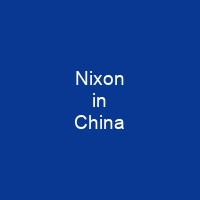Nixon in China is an opera in three acts by John Adams, with a libretto by Alice Goodman. It was inspired by U.S. President Richard Nixon’s 1972 visit to China. The work premiered at the Houston Grand Opera on October 22, 1987, in a production by Peter Sellars. It has since been presented in Europe, North America and in Canada.
About Nixon in China in brief

Nixon laid the groundwork for his overture to China even before he became president. He hoped that détente would put pressure on the North Vietnamese to end the Vietnam War, and he might be able to manipulate the two main communist powers to the benefit of the United States. Nixon’s change, from virulent anti-communist to the American leader who took the first step in improving Sino–American relations, led to a new political adage, “Only Nixon could go to China” The announcement that Nixon would visit China in 1972 made world headlines. Almost immediately, the Soviet Union also invited Nixon for a visit, and improved US-Soviet relations led to the Strategic Arms Limitation Talks. Nixon’sVisit to China was followed closely by many Americans, and scenes of him there were widely aired on television. Some critics dismissed the work, predicting it would soon vanish, but it has since been presented in Europe, North America and in Canada, and it has even been recorded in the UK by the Royal Opera House in London and the Royal College of Music in London. The composer was initially reluctant to write the opera, but eventually decided that the work could be a study in how myths come to be, and accepted the project. He was initially skeptical that Sellars was proposing a satire, but came to believe the opera could show how mythic origins may be found in contemporary history.
You want to know more about Nixon in China?
This page is based on the article Nixon in China published in Wikipedia (as of Nov. 21, 2020) and was automatically summarized using artificial intelligence.







